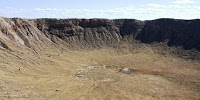SECTION 1: QUESTIONS 1-13
Reading Passage 1
WEATHERING IN THE DESERT

A In the deserts, as elsewhere, rocks at the earth's surface are changed by weathering, which may be defined as the disintegration of rocks where they lie. Weathering processes are either chemical, when alteration of some of the constituent particles is involved; or mechanical, when there is merely the physical breaking apart and fragmentation of rocks. Which process will dominate depends primarily on the mineralogy and texture of the rock and the local climate, but several individual processes usually work together to the common end of rock disintegration.
B The great daily changes in temperature of deserts have long been supposed to be responsible for the disintegration of rocks, either by the differential heating of the various rock-forming minerals or by differential heating between the outer and inner parts of rock masses. However, both field observations and laboratory experiments have led to a reassessment of the importance of ’ exposure to the sun's rays in desert weathering. Almost half a century ago Barton remarked that the buried parts of some of the ancient monuments in Egypt were more weathered than were those parts fully exposed to the sun's rays, and attributed this to the effects of water absorption below the ground surface. Laboratory experiments have shown that rocks subjected to many cycles of large temperature oscillations (larger than those experienced in nature) display no evidence of fissuring or fragmentation, as a result. However, when marked fluctuations of temperature occur in moist conditions small rock fragments quickly form.
C The expansive action of crystallising salts is often alleged to exert sufficient force tondisintegrate rocks. Few would dispute that this mechanism is capable of disrupting fissilenor well-cleaved rocks or rocks already weakened by other weathering agencies; wood is splintered, terracotta tiles disintegrated and clays disturbed by the mechanism, but itsmimportance when acting upon fresh and cohesive crystalline rocks remains uncertain.
D Weathering achieves more than the disintegration of rocks, though this is its mostnimportant geomorphic effect. It causes specific landforms to develop. Many boulders possess a superficial hard layer of iron oxide and/or silica, substances which havemigrated in solution from the inside of the block towards the surface. Not only is the exterior thus case-hardened but the depleted interior disintegrates easily. When weathering penetrates the shell the inside is rapidly attacked and only the hard outer layerremains to give hollowed or 'tortoiseshell' rocks.
E Another superficial layer, the precise nature of which is little understood, is the well-known desert varnish or patina, a shiny coat on the surface of rocks and pebbles and characteristic of arid environments. Some varnishes are colourless, others light brown, yet others so dark a brown as to be virtually black. It's origin is unknown but is significant, for it has been suggested that the varnish grows darker with the passage of time; obviously before such a criterion could be used with confidence as a chronological tool its origin must be known with precision. Its formation is so slow that in Egypt, for example, it has been estimated that a light brown coating requires between 2,000 and 5,000 years to develop, a fully formed blackish veneer between 20,000 and 50,000 years.
F The development of relatively impermeable soil horizons that are subsequently exposed at the surface because of erosion of once overlying, easily eroded materials, and which thus become surface crusts, is widespread in arid regions, although it is also known outside the deserts, and indeed many of the examples in arid lands probably originated in formerbperiods of humid climate. The crusts prevent the waters of occasional torrential downpoursbfrom penetrating deeply into the soil, and thus they contribute to the rapid runoff associated with desert storms. Also, after erosion has cut through the crust and exposed underlying soil layers, the hard layer forms a resistant capping (duricrust) on plateaux and mesas, such as are common in many parts of arid and semi-arid Australia.
G Some duricrust layers have been used as time markers for landforms and geological formations. The necessary conditions for this are that the crust forms fairly rapidly, and that it is sufficiently distinct in appearance to preclude the possibility of confusion with other crusts formed at other times. The Barrilaco calcrete of Mexico for instance is believed to date from about 7,000 B.C. The main silcrete of the northern districts of South Australia is believed to date from the Lower Miocene, the laterite of northern Australia to be of the Lower or Middle Miocene age.